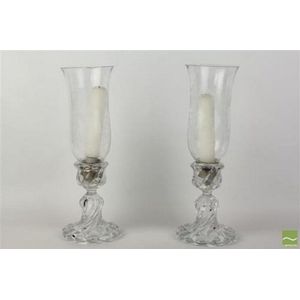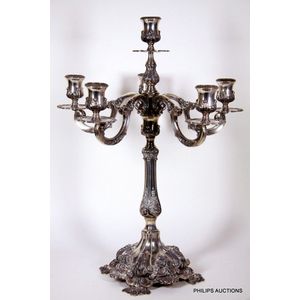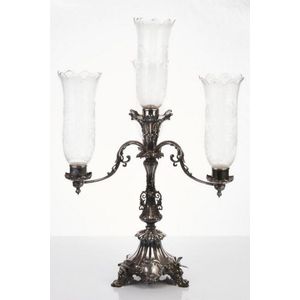Victorian Sheffield Plate Candelabrum with Etched Glass Shades
You must be a subscriber, and be logged in to view price and dealer details.
Subscribe Now to view actual auction price for this item
When you subscribe, you have the option of setting the currency in which to display prices to $Au, $US, $NZ or Stg.
- Victorian Period - The Victorian period of furniture and decorative arts design covers the reign of Queen Victoria from 1837 to 1901. There was not one dominant style of furniture in the Victorian period. Designers used and modified many historical styles such as Gothic, Tudor, Elizabethan, English Rococo, Neoclassical and others, although use of some styles, such as English Rococo and Gothic tended to dominate the furniture manufacture of the period.
The Victorian period was preceded by the Regency and William IV periods, and followed by the Edwardian period, named for Edward VII (1841 ? 1910) who was King of the United Kingdom and the British Dominions and Emperor of India for the brief period from 1901 until his death in 1910. - Cartouche - An ornamental panel in the form of of a shield, oval or rectangular scroll with curling edges. It may be carved into the back of a chair or the top of a sideboard, or present on a piece of silver or jewellery, and contain the initials of the original owner, heraldic symbols, or some other inscription, such as the details of a presentation.
In ceramics the term defines the central area of a vase or similar with a decorative border in one of the shapes above, into which a decorative scene or figures have been painted. - Armorial / Armourial - Bearing a coat of arms. Coats of arms came into general use by feudal lords and knights in in the 12th century, and by the 13th century, arms had spread beyond their initial battlefield use to become a flag or emblem for families in the higher social classes of Europe. They were inherited from one generation to the next. When a family crest is used on individual items of silver or furniture it is an indicator of the aristocratic standing of the family represented.
Armorials were also used to decorate mass produced ceramic souvenir ware by such companies as Goss, Carlton & Shelley, and in these cases the coats of arms displayed were of boroughs and cities.
This item has been included into following indexes:
- candelabra / candelabrum
- candelabra and candlesticks - glass and crystal 308
- candlesticks, types - storm lights / lanterns / shades 48
Visually similar items

Baccarat crystal Hurricane lamps with moulded and acid etched bambons shades sitting upon swirl scalloped bases. Marked to base. Height 36 cm

A silver plate neoclassical style three light candelabrum, of knopped form with twin curvaceous arms with conical nozzles and pans, with a removable top section allowing use a single candlestick, with simple gadroon and thread decoration and raised on a sp

A sterling silver candelabrum, 20th century, with mark of Topazio, Portugal, of elaborate foliate form, the five armed candelabrum with scrolling arms and acanthus decorated sconces, a shaped slender baluster stem to a richly moulded base with leaf, scroll

Pair Baccarat crystal Candelabras, each with suspended crystal lustres & etched hurricane shades. Height 57 cm (each) (total)
